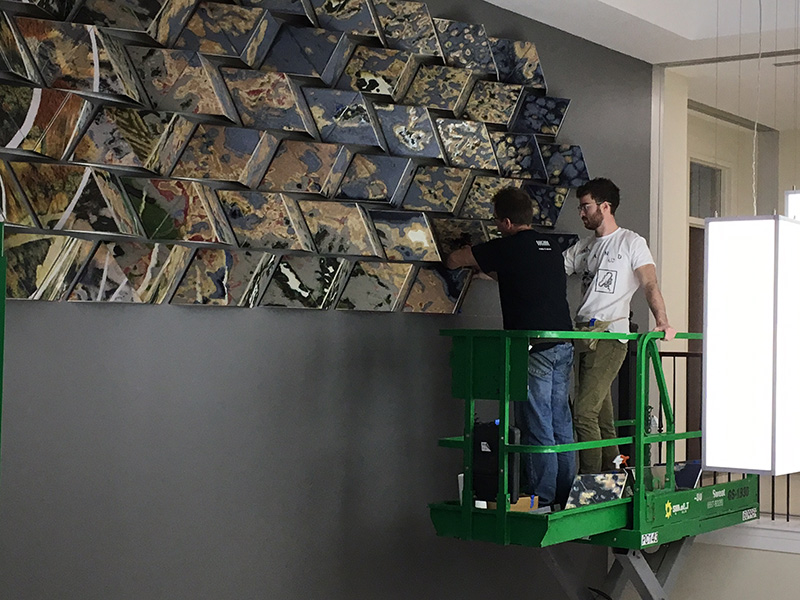

New artwork at Shideler Hall funded through Ohio Percent for Art Program
Brian Boldon, artist, and Garrett Goben, a master's of fine arts student in painting, install the new artwork in Shideler Hall, which was recently renovated. Shideler houses Miami University's department of geology and environmental earth science, the geography department as well as the Institute for the Environment and Sustainability. (Photo by Claire Wagner)
By Margo Kissell, university news and communications
If you take a closer look at the new artwork hanging in Shideler Hall, you might spot mining operations and other distressed landscapes, aerial images of Ohio’s farmland, highways, even a few trucks.
Artists Amy Baur and Brian Boldon were selected to create “Flux” to hang near the central staircase in Shideler, which houses Miami University’s department of geology and environmental earth science, the geography department as well as the Institute for the Environment and Sustainability.
Every vantage point — the first floor, the staircase and the second floor — provides a fresh perspective of the ceramic art piece that is 28 feet wide and about 12 feet tall and was funded through the Ohio Percent for Art Program. Baur and Boldon, whose In Plain Sight studio is in Minneapolis, applied through the Ohio Arts Council.
The Ohio Legislature in 1990 established the program, which provides funds for the acquisition, commissioning and installation of works of art for certain new or renovated public buildings. Whenever the legislature appropriates more than $4 million for a public building, the law requires one percent of the total appropriation be allocated for artwork.
About $25 million in renovations were recently completed at Shideler.
The married couple said they’ve done about 35 public art projects, many of them for universities. Both had been college professors (he was head of ceramics at Michigan State University for 14 years; she an adjunct in photography there).
This project grabbed their attention because of the connection to geography and geology. “Ceramics share something with geology,” he said, noting he works with metals, alkalines and clay.
Boldon became interested in an idea of using form and image together in 2004. “This new technology came out of Europe, where you could actually print high resolution photographic images with glaze,” he said.
With “Flux,” they projected images onto 640 porcelain equilateral triangular tiles. They were pieced together to form 160 rhombuses across 13 rows that fold together into a lattice. The tiles were attached to aluminum backing.
The upper left and lower right are from photographic images Baur assembled of Earth, including the bottoms of pit mines and grids showing oilsands mining operations in Alberta, Canada.
Moving lower left through the middle to the upper right is Boldon’s design representing the geologic process such as erosion.
“Everything about this piece was about the whole flux and flow,” Boldon said Friday as they wrapped up the installation with the help of Garrett Goben, a master’s of fine arts student in painting. Goben was tapped to help assemble the piece because he had experience in that area. When the work was done, he stepped back and admired the artwork from a distance.
“It’s not the kind of thing you come by and look at one time,” he said. “It’s the kind of thing you see differently each time.”
Claire Wagner, university news and communications, contributed to this story.

